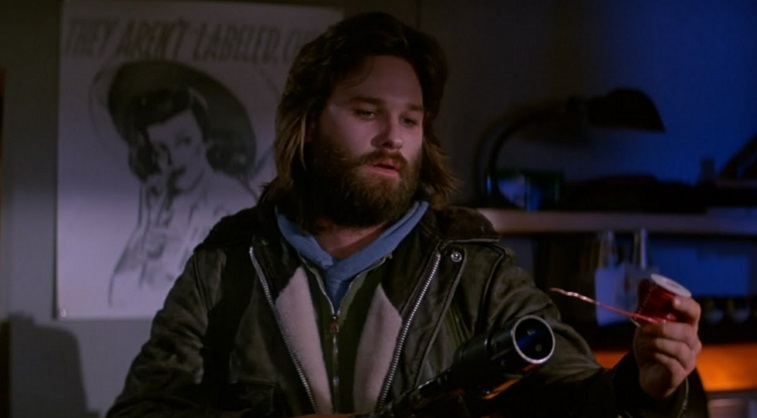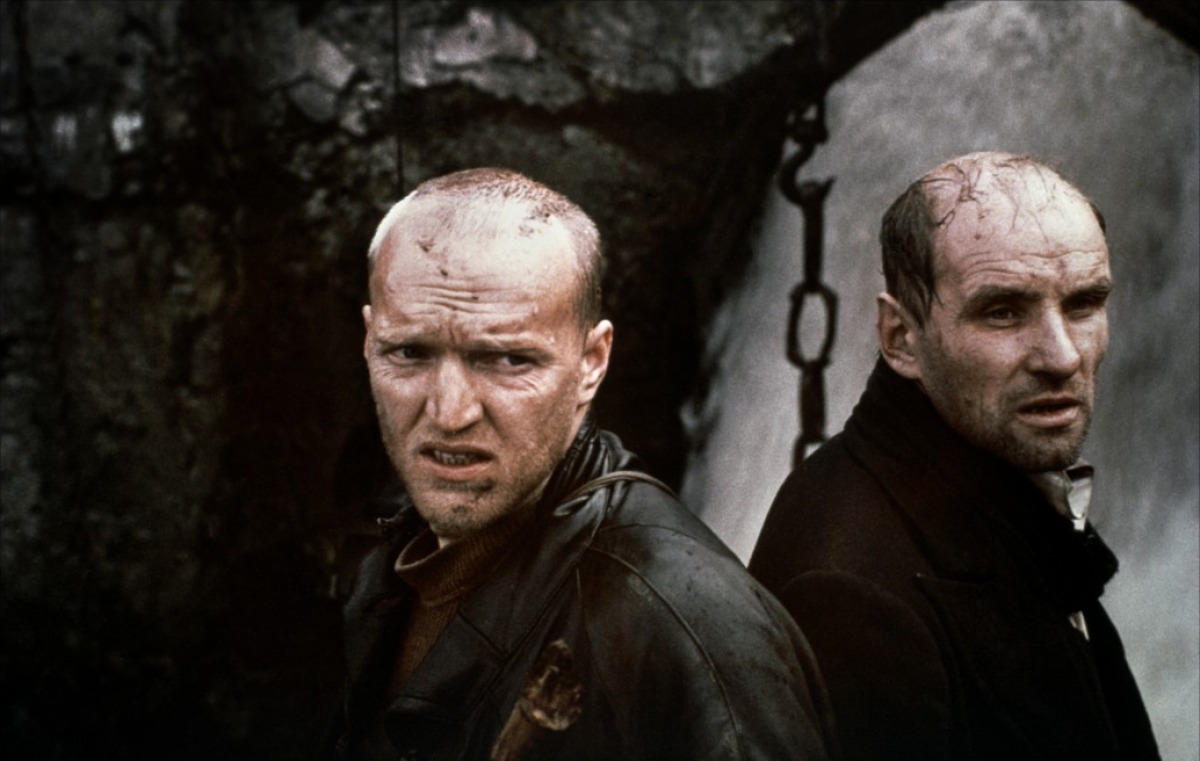5. The Thing

For some of its human visitors, the Shimmer becomes a test of mental endurance. How much unexplained phenomena can you handle before you break down? For Kane (Oscar Isaac), it was meeting his doppelgänger. He left evidence of his demise through a video recording in which he annihilates himself via a phosphorous grenade.
After Lena sees this, she knows that the Kane who returned from the Shimmer isn’t really her husband. When she finally escapes from the Shimmer and meets the duplicate of Kane, he admits that he isn’t really her husband. He then asks her if she is really Lena. She doesn’t respond and just holds him.
The ambiguity of the ending might frustrate some, leaving open a series of possibilities: is Lena, who has been infected by the Shimmer, an unreliable narrator? The shifting color of her irises might indicate so.
In “The Thing,” we get an equally ambiguous ending. In this science fiction horror classic, we follow a group of American researchers in Antarctica as they face off against a shape-shifting alien.
Aside from the awesome body horror, the film is just as much about the psychological toll of dealing with unspeakable and terrifying phenomena as we see characters break down and turn against each other. Directed by the great John Carpenter (and notably derided upon its release), “The Thing” is already a classic, and you can’t really call yourself a science fiction or a horror fan if you haven’t seen it.
4. Solaris

After we strip away the horror and cerebral science fiction, at its core, “Annihilation” is a tragic love story. It’s as much about the doomed relationship between Lena and Kane as it is about comprehending an incomprehensible extraterrestrial being.
It’s not uncommon for cerebral science fiction to deal with the topic of love, the deepest of human emotion. We also saw this in the excellent Christopher Nolan’s space-adventure film “Interstellar.” But it is perhaps nowhere better deconstructed than in Andrei Tarkovsky’s “Solaris” and its wonderful remake in 2002 by Steven Soderbergh.
In comparison, Soderberg’s remake might be closer in spirit to “Annihilation” as it focuses far more on the romantic element than Tarkovsky’s did – which, in all fairness, delves into much grander themes that Soderbergh’s only scratches the surface of. But just like “Annihilation,” it portrays the human emotion of love as something perhaps not divine, but necessary.
Something that comes the closest to a higher power, something that gives meaning to a perhaps meaningless universe. Just like in “Solaris,” the main character in “Annihilation” is willing to sacrifice herself just to be closer to her beloved. With the awareness of death, of total annihilation, love is the only light that can be found in the void.
It’s up to you which “Solaris” you’d rather see – I’d also recommend the original novel by Stanislaw Lem. Both have their own particular weaknesses: the original is nearly three hours long while the remake dilutes the philosophical themes. But both are extraordinary pieces of science fiction that, like “Annihilation,” will stay on your mind long after.
3. Under the Skin

I don’t think I’ve seen a scarier movie in recent years than “Under the Skin.” That’s all due to Jonathan Glazer’s meticulous and cold directing and its use of ambient and strange music that gives this film an alien feel. It’s a movie from the point of view of an alien predator, who, just like a monstrous insect, seduces its prey so it can harvest its remains for her own needs – or the needs for her alien race. The original novel makes it clear that human beings are nothing more than a food delicacy on their planet, but the film never makes it clear.
The scenes that especially terrify me are the ones focusing on the victims. It seems like they are drugged as they fall into the deathly grip of the alien. We see them walking mindlessly to the alien – in the form of Scarlett Johansson – as they slowly sink into black liquid goo.
When the second victim is submerged into the goo, he sees another victim drifting next to him. When the second victim touches him, hoping to find some comfort in this terrifying void, the first victim’s body falls apart. We see his loose skin drifting into that darkness. We see his gory remains being carried through a trough.
“Under the Skin,” just like “Annihilation,” is one of the greatest science fiction films of recent years. It’s a dark and brutal film, but it’s also a strangely tender character piece of a predatory alien creature (wonderfully played by Johansson) finding her humanity.
2. Invasion of the Body Snatchers

There are mixed Interpretations of the allegorical meanings of the original 1956 “Invasion of the Body Snatchers.” Judging by its time period, the menacing aliens of the story – the body snatchers – could easily represent both the parasitic meme of communism or McCarthyism. The original is a great film, even with its compromised ending – a happy ending forced by the studio. For this entry, we are going to focus on the excellent 1978 remake which luckily has the opposite of a studio-mandated ending – and is infamously terrifying.
The 1978 remake is less obvious with its allegory and the body snatchers of this film could be perceived as the more broad terror of ‘conformity.’ The body snatchers replace the original human with their own emotionless duplicate. There might be nothing more terrifying than ordinary people letting evil run rampant, or conforming to an evil society if it means having a place in this world.
We’ve seen plenty of examples of this in totalitarian countries throughout history: people informing on each other, people acting on the same prejudices approved by the state, people doing the government’s evil bidding. It’s understandable in some way: the only way to be left alone or evade tyranny is to act as merciless and soulless as everyone else.
The film features an excellent cast: Donald Sutherland, Veronica Cartwright, Jeff Goldblum, and even Leonard Nimoy. Even by today’s standards, the film is still unsettling and the alien is one of the most terrifying in cinema history. The third remake in 1993 by Abel Ferrara called simply “Body Snatchers” is also worth a watch. The fourth remake in 2007, “The Invasion,” sadly crumbled under studio pressure and is better left forgotten.
1. Stalker

Be careful what you wish for – or better yet, be careful about your innermost wish. What you think you want might not be what you want. The very thing you want might be something you’ve hidden from yourself, consciously or unconsciously. Your innermost wish might tell you something about yourself, something you wished you’d never knew.
In “Stalker,” three characters traverse through a mysterious territory known as the Zone. The origins of this place are filled with mystery, but it’s said to have a place called the Room, where the visitor will have his deepest wish fulfilled.
A Stalker is someone who leads men to this forbidden place, which is sealed by the government and any interlopers are shot on sight. The three main characters are simply referred to as the Stalker (Alexander Kaidanovsky), the Writer (Anatoly Solonitsyn) and the Professor (Nikolai Grinko). But what wish is truly being granted – and what is the thing we really wish for?
Just like in “Annihilation,” we have characters traversing an alien territory. While the Shimmer might be more frightening in a visual sense – there’s no monstrous mutations in sight – there’s the feeling that the zone plays with each visitor’s mind. There are implied mortal dangers in the zone: there’s desolation and shots of death. But there’s an interesting interpretation that the Zone and its power doesn’t really exist. That its power merely comes forth from the belief of the Stalker and his followers. It’s faith that creates reality.
“Stalker” is a heavy but oh-so worthwhile investment. It’s nearly three hours long and it’s devoid of traditional action or spectacle. It’s an Tarkovsky film, so that means beautiful photography and characters asking deeply introspective questions. Any film buff knows it’s a masterpiece. But if you haven’t seen it and want to dive into something really interesting, enter the Zone with Tarkovsky as your stalker. You might learn something about yourself.
Author Bio: Chris van Dijk is a writer and a self-proclaimed cinematic-connoisseur who started his unhealthy obsession with film at a very young age. He’s famous for being an incredible slob, taking himself way too seriously and getting along brilliantly with anyone who agrees with him.